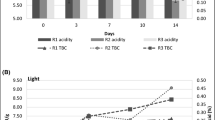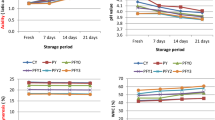Abstract
The objective of this study was to determine the quality changes and shelf life of ready-to-eat roasted Antarctic krill, either untreated (CT) or treated with sodium diacetate (SD) or sodium diacetate and a deoxidizer (SDD), during storage at room temperature (25°C) by using sensory, physiochemical, and microbial assessment. Additionally, fluoride accumulation in this food product was used to evaluate its safety. Analysis showed that the addition of SD and SDD resulted in better sensory scores compared of that of CT samples (P <0.05). Accordingly, microorganism growth and total basic nitrogen (TVB-N) were maintained at a low level for the duration of storage with SD and SDD treatments. The total viable counts of SD and SDD reached (4.58 ± 0.08) log (CFU g−1) and (4.20 ± 0.11) log (CFU g−1), respectively. The mold was found after 6 and 18 days for SD and SDD treatment, and the numbers reached 5.2 × 106 and 8.5 × 104 respectively at the end of shelf life. The TVB-N values from CT continuously increased during the whole storage. While TVB-N values from SD and SDD remained significantly less change (P <0.05) during the early 20 days of the storage, and the values reached (12.11 ± 0.07) mg (100 g)−1 and (10.88 ± 0.15) mg (100 g)−1 on day 33 and day 70, respectively. Importantly, SDD treatment effectively minimized the oxidation values and retained the color of ready-to-eat roasted Antarctic krill. Our results showed that the shelf life of ready-to-eat roasted Antarctic krill treated with SDD was extended by up to 52 days. Additionally, rats fed ready-to-eat roasted Antarctic krill showed accumulation of fluoride exclusively in the thighbone. The accumulation of fluoride residues in the thighbone showed concentration-dependent. The concentrations of fluoride residues in rats were (1760.03 ± 38.21), (2371.52 ± 42.15) mg kg−1 and (3615.44 ± 30.53) mg kg−1, which were less than sodium fluoride feeding group (4621.01 ± 28.67) mg kg−1. The results suggested that the SD and SDD treatments led to better quality and shelf life extension of ready-to-eat roasted Antarctic krill during storage at room temperature (25°C). Therefore, the ready-to-eat roasted Antarctic krill can be of great interest to the seafood industry.
Similar content being viewed by others
References
Bao, J., Chen, L., and Liu, T., 2019. Dandelion polysaccharide suppresses lipid oxidation in Antarctic krill (Euphausia superba). International Journal of Biological Macromolecules, 133: 1164–1167.
Butts-Wilmsmeyer, C. J., Mumm, R. H., Rausch, K. D., Kandhola, G., Yana, N. A., Happ, M. M., et al., 2018. Changes in phenolic acid content in maize during food product processing. Journal of Agricultural and Food Chemistry, 66: 3378–3385.
Camargo, J. A., 2003. Fluoride toxicity to aquatic organisms: A review. Chemosphere, 50: 251–264.
Cavan, E. L., Belcher, A., Atkinson, A., Hill, S. L., Kawaguchi, S., McCormack, S., et al., 2019. The importance of Antarctic krill in biogeochemical cycles. Nature Communication, 10: 4742–4754.
Chen, J., Cao, J., Wang, J., Jia, R., Xue, R., Li, Y., et al., 2013. Effects of fluoride on growth, body composition, and serum biochemical profile in a freshwater teleost, Cyprinus carpio. Environmental Toxicology and Chemistry, 32: 2315–2321.
Descamps, S., Tarroux, A., Cherel, Y., Delord, K., Godø, O. R., Kato, A., et al., 2016. At-sea distribution and prey selection of Antarctic petrels and commercial krill fisheries. PLoS One, 11: 1–18.
Ghani, M. A., Barril, C., Bedgood, D. R., and Prenzler, P. D., 2017. Measurement of antioxidant activity with the thiobarbituric acid reactive substances assay. Food Chemistry, 230: 195–207.
Haouet, M. N., Tommasino, M., Mercuri, M. L., Benedetti, F., Bella, S. D., Framboas, M., et al., 2018. Experimental accelerated shelf life determination of a ready-to-eat processed food. Italian Journal of Food Safety, 7: 189–192..
Hidalgo, F. J., and Zamora, R., 2017. Food processing antioxidants. Advances in Food and Nutrition Research, 81: 31–64.
Jech, J. A., 1979. Comparative uptake of fluoride from sodium fluoride, ammonium fluoride, and barium fluoride in rat teeth when predominantly administered in the pre-eruptive stage of development. Calcified Tissue International, 27: 117–119.
Ji, W., Zhang, C., and Ji, L., 2017. Two novel bioactive peptides from Antarctic krill with dual angiotensin converting enzyme and dipeptidyl peptidase IV inhibitory activities. Journal of Food Science, 82: 1742–1749.
Jiang, Z., Neetoo, H., and Chen, H., 2011. Control of Listeria monocytogenes on cold-smoked salmon using chitosan-based antimicrobial coatings and films. Journal of Food Science, 76: 22–26.
Kidd, P. M., 2007. Omega-3 DHA and EPA for cognition, behavior, and mood: Clinical findings and structural-functional synergies with cell membrane phospholipids. Alternative Medicine Review, 12: 207–227.
Lan, C., Zhao, Y. Q., Li, X. R., and Wang, B., 2019. High Fischer ratio oligopeptides determination from Antartic krill: Preparation, peptides profiles, and in vitro antioxidant activity. Journal of Food Biochemistry, 43: 1–12.
Li, X., Zhang, M., Wang, Y., Wang, X., Ma, H., Li, P., et al., 2018. Direct detection of fluoride ions in aquatic samples by surface-enhanced Raman scattering. Talanta, 178: 9–14.
Ma, X., Liu, C., Wang, C., Ma, X., Che, S., Feng, X., et al., 2019. Effects of three products from Antarctic krill on the nitrogen balance, growth, and antioxidation status of rats. Food Science and Nutrition, 7: 2760–2768.
Parolini, C., Bjorndal, B., Busnelli, M., Manzini, S., Ganzetti, G. S., Dellera, F., et al., 2017. Effect of dietary components from Antarctic krill on atherosclerosis in apoE-deficient mice. Molecular Nutrition and Food Research, 61: 1700098–1700108.
Peng, Y., Ji, W., Zhang, D., Ji, H., and Liu, S., 2019. Composition and content analysis of fluoride in inorganic salts of the integument of Antarctic krill (Euphausia superba). Scientific Reports, 9: 7853.
Sands, M., Nicol, S., and McMinn, A., 1998. Fluoride in Antarctic marine crustaceans. Marine Biology, 132: 591–598.
Shaviklo, G. R., Olafsdottir, A., Sveinsdottir, K., Thorkelsson, G., and Rafipour, F., 2011. Quality characteristics and consumer acceptance of a high fish protein puffed corn-fish snack. Journal of Food Science and Technology, 48: 668–676.
Sun, D., Zhang, L., Chen, H., Feng, R., Cao, P., and Liu, Y., 2017. Effects of Antarctic krill oil on lipid and glucose metabolism in C57BL/6J mice fed with high fat diet. Lipids in Health and Disease, 16: 218–225.
Suzuki, T., and Shibata, N., 1990. The utilization of Antarctic krill for human food. Food Reviews International, 6: 119–147.
Tenuta-Filho, A., and Alvarenga, R. C., 1999. Reduction of the bioavailability of fluoride from Antarctic krill by calcium. International Journal of Food Sciences and Nutrition, 50: 297–302.
Turner, C. H., 1996. Fluoride and the FDA: A curious case. Journal of Bone and Mineral Research, 11: 1369–1371.
Wang, H., Wu, Y., Wang, N., Yang, L., and Zhou, Y., 2019. Effect of water content of high-amylose corn starch and glutinous rice starch combined with lipids on formation of starch-lipid complexes during deep-fat frying. Food Chemistry, 278: 515–522.
Wang, Z. C., Yan, Y., Nisar, T., Sun, L., Su, P., Chen, D. W., et al., 2018. Influence of postmortem treatment with nitric oxide on the muscle color and color stability of tilapia (Oreochromis niloticus) fillets. Nitric Oxide, 76: 122–128.
Xia, Z., Zhai, X., Liu, B., and Mo, Y., 2016. Conductometric titration to determine total volatile basic nitrogen (TVB-N) for post-mortem interval (PMI). Journal of Forensic and Legal Medicien, 44: 133–137.
Xie, D., Gong, M., Wei, W., Jin, J., Wang, X., Wang, X., et al., 2019. Antarctic krill (Euphausia superba) oil: A comprehensive review of chemical composition, extraction technologies, health benefits, and current applications. Comprehensive Reviews in Food Science and Food Safety, 18: 514–534.
Yoshitomi, B., and Nagano, I., 2012. Effect of dietary fluoride derived from Antarctic krill (Euphausia superba) meal on growth of yellowtail (Seriola quinqueradiata). Chemosphere, 86: 891–897.
Zerbini, A. N., Adams, G., Best, J., Clapham, P. J., Jackson J. A., and Punt, A. E., 2019. Assessing the recovery of an Antarctic predator from historical exploitation. Royal Society Open Science, 6: 190368–190389.
Zhao, Y. Q., Zhang, L., Tao, J., Chi, C. F., and Wang, B., 2019. Eight antihypertensive peptides from the protein hydrolysate of Antarctic krill (Euphausia superba): Isolation, identification, and activity evaluation on human umbilical vein endothelial cells (HUVECs). Food Research International, 121: 197–204.
Zuo, H., Chen, L., Kong, M., Qiu, L., Lü, P., Wu, P., et al., 2018. Toxic effects of fluoride on organisms. Life Sciences, 198: 18–24.
Acknowledgements
This work was supported by the National Key R&D Program of China (Nos. 2020YFD0901204, 2017YFC1600706), and the Natural Science Foundation of Shanghai (No. 22ZR 1478500). We highly appreciated that the 36th Antarctic expedition of China supported the samples of Antarctic krill.
Author information
Authors and Affiliations
Corresponding author
Rights and permissions
About this article
Cite this article
Yang, X., Shi, Y., Cai, Y. et al. Quality Changes and Safety Evaluation of Ready-to-Eat Roasted Antarctic Krill (Euphausia superba) During Storage at Room Temperature (25°C). J. Ocean Univ. China 22, 235–241 (2023). https://doi.org/10.1007/s11802-023-5162-z
Received:
Revised:
Accepted:
Published:
Issue Date:
DOI: https://doi.org/10.1007/s11802-023-5162-z




